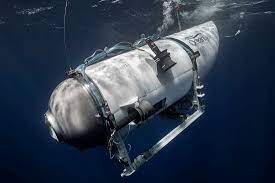A submersible carrying five people to the Titanic imploded near the site of the shipwreck and killed everyone on board, US authorities have said, bringing a tragic end to a saga that included an urgent around-the-clock search and a worldwide vigil for the missing vessel.
US Coast Guard officials said during a news conference on Thursday that they’ve notified the families of the crew of the Titan, which had been missing since Sunday.
The sliver of hope that remained for finding the five men alive was wiped away early Thursday when the submersible’s 96-hour supply of oxygen was expected to run out, and the Coast Guard announced that debris had been found roughly 1,600 feet from the Titanic in North Atlantic waters.

OceanGate Expeditions, the company that owned and operated the submersible, said in a statement that all five people in the vessel, including CEO and pilot Stockton Rush, ‘have sadly been lost.’
The others on board were: two members of a prominent Pakistani family, Shahzada Dawood and his son Suleman Dawood; British adventurer Hamish Harding; and Titanic expert Paul-Henri Nargeolet.
Search for clues about what happened to continue
Rescuers rushed ships, planes, and other equipment to the site of the disappearance.
Authorities were hoping underwater sounds detected on Tuesday and Wednesday might help narrow their search, whose coverage area had been expanded to thousands of miles — twice the size of Connecticut and in waters 4 kilometers deep.
The Coast Guard indicated on Thursday that the sounds were likely generated by something other than the Titan. Mauger said it was too soon to say whether the implosion happened at the time of the submersible’s last communication on Sunday.
But it was not detected by sonar buoys used by search crews, he said, which suggests it happened before they arrived several days ago. The Coast Guard will continue searching near the Titanic for more clues about what happened to the Titan.
Efforts to recover the submersible and the remains of the five men who died will also continue, Mauger said.
The Titan launched at 6 am on Sunday and was reported overdue on Sunday afternoon about 700 kilometers south of St. John’s, Newfoundland, as it was on its way to where the Titanic sank more than a century ago.
By Thursday, when the oxygen supply was expected to run out, there was little hope of finding the crew alive.
Media spectacle
Broadcasters around the world started newscasts at the critical hour on Thursday with news of the submersible.
At least 46 people successfully traveled on OceanGate’s submersible to the Titanic wreck site in 2021 and 2022, according to letters the company filed with a US District Court in Norfolk, Virginia, that oversees matters involving the Titanic shipwreck.
But questions about the submersible’s safety were raised by former passengers.
One of the company’s first customers likened a dive he made to the site two years ago to a suicide mission. During the 2 1/2-hour descent and ascent, the lights were turned off to conserve energy, he said, with the only illumination coming from a fluorescent glow stick.
The dive was repeatedly delayed to fix a problem with the battery and the balancing weights. In total, the voyage took 10 1/2 hours.
The submersible had seven backup systems to return to the surface, including sandbags and lead pipes that drop off and an inflatable balloon.
Nicolai Roterman, a deep-sea ecologist and lecturer in marine biology at the University of Portsmouth, England, said the disappearance of the Titan highlights the dangers and unknowns of deep-sea tourism.






